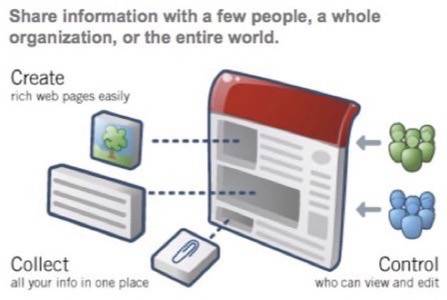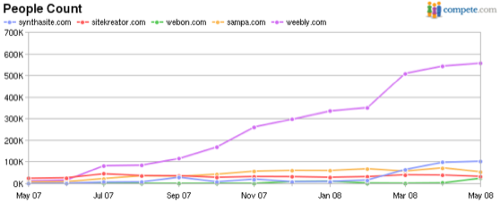In Web 1.0 there were a number of browser-based website creation platforms – e.g. Geocities, Angelfire, Tripod, Homestead and Brinkster (I myself used nearly all of those, back in the day). These apps were very popular in the mid to late 90’s, because they made web publishing relatively easy. The most successful one, Geocities, was eventually acquired by Yahoo! in 1999. Do these tools still exist, in the Web 2.0 era?

Well, on the social web, blogging platforms such as blogger.com, LiveJournal, TypePad and WordPress.com have to a large extent usurped Geocities. Not to mention social networks like MySpace and Facebook. However the ‘read/write web’ has expanded the market for web publishing exponentially, so there is still room for traditional website building platforms.
Market Players
Geocities itself is still active in the website creation market. Here are some of its competitors:

- Google Sites (it evolved out of one of Google’s acquisitions, JotSpot, and is now available for free separately from Google Apps)
- Weebly (a Y Combinator company)
- SynthaSite (our coverage)
- Sampa (our coverage)
- SiteKreator
- Webon (a recently launched offering from Web 1.0 stalwart Lycos)
Who’s using these products? Website creation platforms are aimed at people who just want a regular website; for example people who want to chronicle their wedding or holiday, families who want to track their family history and growth, or retailers who want to build a web presence.
Often these tools have ‘drag and drop’ functionality, so you can create a new website in a matter of hours without needing to know HTML or have particular design skills. Lycos told us that their product Webon is “geared toward more casual users, e.g. parents, travelers, shutterbugs, who want more control and a more stylized web presence than typical blogging tools or social network profiles allow for.”
Note that you could argue that DIY social networks like Ning are competing in this space, although Ning co-founder Marc Andreessen thinks otherwise. I’m inclined to agree with him, because social networks, blogs, wikis, and websites are all different beasts.
Social Web Twist
Website builder platforms in the web 2.0 era, where mashups and open data are common, typically offer ways to integrate with 3rd party apps. This can take the form of widgets, or even utilizing other sites’ APIs. This is probably the biggest difference between Geocities 1.0 and the 2.0 era web publishing platforms. But also these platforms usually offer the ability to add blogs, RSS feeds, multimedia, privacy controls, and more.
Google Sites diagram, from their homepage

As an example of what these products now offer, Lycos told us recently that Webon supports the OpenSocial API “for thousands of add-ons and widgets (such as iGoogle gadgets and Google FriendConnect), with no HTML or CSS knowledge needed, as well as OpenID to enable DIY social network connections.”
Another common feature in the new website creation tools is use of Ajax to build sites. While at the Web 2.0 Expo a couple of months ago, I dropped by the SynthaSite booth and was very impressed with the rich functionality and the ability to drag n’ drop ajax widgets.
Who’s Leading This Market?
Geocities and Google Sites have the biggest presence, simply because of their bigco backing. Among the startups, according to stats from Compete, the leading small co is Weebly with SynthaSite showing positive growth.

Conclusion
An old cliche that Web entrepreneurs often wheel out at press time is that the market pie (for whatever segment they’re in) is only getting bigger, so there’s plenty of room for them and their competitors too. Well in the case of website creation tools, that’s certainly true! One of the primary characteristics of the social web – aka web 2.0 – is that anyone can easily publish content to the Web. So there is a lot more need these days, compared to the 90’s, for web publishing platforms of all varieties. Many RWW readers probably use blogging and/or social network tools, and micro-publishing tools like Twitter and FriendFeed. But for many other people, straight website creation tools – like Geocities and its many competitors – fit their needs better.
To finish, here’s a brain teaser for you: what will Geocities 3.0 look like? 😉





















